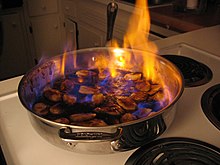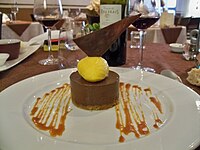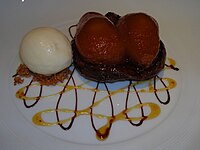
Dessert is a course that concludes a meal. The course consists of sweet foods, such as cake, and possibly a beverage such as dessert wine and liqueur. Some cultures sweeten foods that are more commonly savory to create desserts. In some parts of the world there is no tradition of a dessert course to conclude a meal.

A mousse is a soft prepared food that incorporates air bubbles to give it a light and airy texture. Depending on preparation techniques, it can range from light and fluffy to creamy and thick. A mousse may be sweet or savoury.
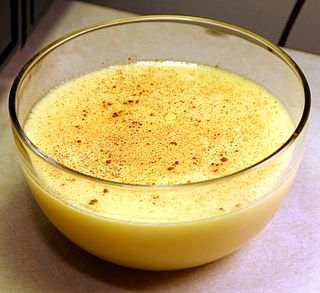
Custard is a variety of culinary preparations based on sweetened milk, cheese, or cream cooked with egg or egg yolk to thicken it, and sometimes also flour, corn starch, or gelatin. Depending on the recipe, custard may vary in consistency from a thin pouring sauce to the thick pastry cream used to fill éclairs. The most common custards are used in custard desserts or dessert sauces and typically include sugar and vanilla; however, savory custards are also found, e.g., in quiche.
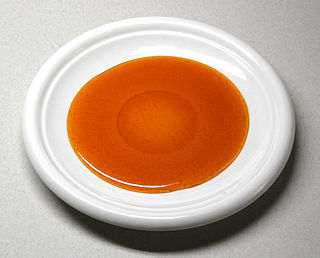
Caramel is an orange-brown confectionery product made by heating a range of sugars. It can be used as a flavoring in puddings and desserts, as a filling in bonbons or candy bars, or as a topping for ice cream and custard.

Crème anglaise, custard sauce, pouring custard, or simply custard is a light, sweetened pouring custard used as a dessert cream or sauce. It is a mix of sugar, egg yolks, and hot milk usually flavoured with vanilla.
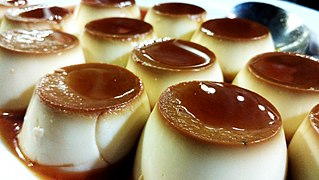
Crème caramel, flan, caramel pudding, condensed milk pudding or caramel custard is a custard dessert with a layer of clear caramel sauce.

A soufflé is a baked egg dish originating in France in the early 18th century. Combined with various other ingredients, it can be served as a savoury main dish or sweetened as a dessert. The word soufflé is the past participle of the French verb souffler, which means to blow, breathe, inflate or puff.

Cheesecake is a dessert made with a soft fresh cheese, eggs, and sugar. It may have a crust or base made from crushed cookies, graham crackers, pastry, or sometimes sponge cake. Cheesecake may be baked or unbaked, and is usually refrigerated.
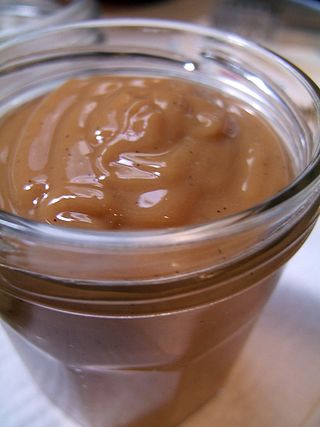
Dulce de leche, caramelized milk, milk candy or milk jam is a confection popular in Latin America, France, Poland and Philippines prepared by slowly heating sugar and milk over a period of several hours. The resulting substance, which takes on a spreadable, sauce-like consistency, derives its rich flavour and colour from non-enzymatic browning. It is typically used to top or fill other sweet foods.

Panna cotta is an Italian dessert of sweetened cream thickened with gelatin and molded. The cream may be aromatized with coffee, vanilla, or other flavorings.

Chocolate syrup is a sweet, chocolate-flavored condiment. It is often used as a topping or dessert sauce for various desserts, such as ice cream, or mixed with milk to make chocolate milk or blended with milk and ice cream to make a chocolate milkshake. Chocolate syrup is sold in a variety of consistencies, ranging from a thin liquid that can be drizzled from a bottle to a thick sauce that needs to be spooned onto the dessert item.

Molten chocolate cake is a French dessert that consists of a chocolate cake with a liquid chocolate core. It is named for that molten center, and it is also known as mi-cuit au chocolat, chocolat coulant ("flowing"), chocolate lava cake, or simply lava cake. It should not be confused with fondant au chocolat, a recipe that contains little flour, but much chocolate and butter, hence melting on the palate.
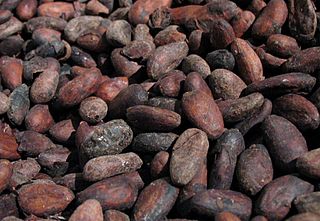
Chocolate liqueur is a chocolate flavored liqueur made from a base liquor of whisky or vodka. Unlike chocolate liquor, chocolate liqueur contains alcohol. Chocolate liqueur is often used as an ingredient in mixology, baking, and cooking.
The second season of Top Chef: Just Desserts was broadcast on Bravo. It featured 14 pastry chefs fighting to win the title of Top Chef.

Blueberry sauce is a sauce prepared using blueberries as a primary ingredient. It is typically prepared as a reduction, and can be used as a dessert sauce or savory sauce depending on the preparation. It can also be used in the preparation of the blueberry Martini.
The first season of Top Chef: Just Desserts was broadcast on Bravo. It featured 12 pastry chefs fighting to win the title of Top Chef.


